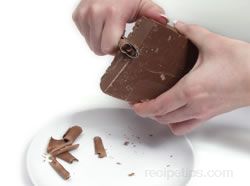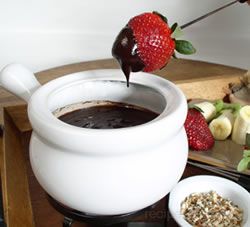|
|
A type of flavoring, coating, syrup, candy, dessert, or beverage made from the seeds of the cocoa tree. The seeds, also referred to as cocoa beans, are husked, roasted, and then ground into a form such as liquid, solid or powder that serves as the base from which all types of sweetened or unsweetened chocolate are made. Unsweetened chocolate begins as a combination of ground cocoa and other ingredients, which is a type of chocolate often suggested for many recipes. Also known as Baker's chocolate, unsweetened chocolate is seldom used for eating in a plain form because the flavor is too bitter tasting.
Chocolate that has been flavored to enhance the taste is generally referred to as sweetened chocolate, a variety produced with different levels of sweetness. Bittersweet, semisweet and sweet varieties such as milk chocolate are common types of sweet chocolate that have had other ingredients added, such as sugar, vanilla, cocoa butter, milk powder, and/or chocolate liquor. Popular for use in candies, the bittersweet, semisweet, and milk chocolate are produced in solid bars or are used as a coating on confections that are typically to be eaten out of hand. |
|
Note:
Cacao refers to the tree from which the beans are harvested and processed.
Cocoa refers to what is produced after the bean is processed.
Cocoa Butter refers to the fat content that is present in the cacao beans |
|
Types of Chocolate: |
|
Unsweetened Chocolate
Unsweetened chocolate is chocolate in the purest form. Made from cacao beans that have been fermented, dried, roasted and then ground, it is commonly known as chocolate liquor in the United States and cocoa mass in the UK. Consisting of approximately 50% cocoa butter, unsweetened chocolate is mainly used for cooking and baking and generally not for eating. |
|
|
|
Bittersweet Chocolate
Bittersweet chocolate is produced by blending at least 35% chocolate liquor with up to 50% cocoa butter, sugar and vanilla. Dark in color and used primarily for baking, bittersweet chocolate provides a rich and deep chocolate flavor to recipes. |
|
Semisweet Chocolate
This variety of chocolate uses the same percentages of liquor and cocoa butter (35% chocolate liquor and up to 50% cocoa butter) as the bittersweet but has additional sugar added. Adding sugar to the mixture creates a much sweeter chocolate that works great for baking. |
|
 |
Milk Chocolate
Milk chocolate is a very sweet chocolate that is produced by combining chocolate liquor with cocoa butter, vanilla and sugar. This chocolate also has milk solids added which gives the chocolate a lighter color and smoothness. Many people prefer the flavor of milk chocolate over the darker chocolates because it lacks the bitterness that can be found in other chocolates. |
|
White Chocolate
White chocolate is not a chocolate due to the fact that it does not contain chocolate liquor. White chocolate is made from cocoa butter, sugar, vanilla and milk. Similar to the consistency and texture of chocolate, it is still commonly used in baking and cooking. |
|
|
|
Cocoa Powder
Cocoa powder is produced when the chocolate liquor has been pressed and removed of most of its cocoa butter. After being dried, it is processed to form cocoa powder. There are two varieties of cocoa powder: unsweetened, sometimes known as natural, and Dutch-processed. Dutch-process has an alkali agent added to neutralize the acids that are present. This creates a reddish colored powder that dissolves easily in water. Unsweetened powder is very bitter due to the acids present and adds a deep chocolate flavor to recipes |
| Couverture is a high quality chocolate that contains at least 32% cocoa butter. Usually found in specialty chocolate stores, it is mainly used for dipping and creating shells for candies. |
Couverture |
|
|
Chocolate Chips
Chocolate chips are a processed chocolate available in a variety of flavors and shapes. A good chip will hold its shape when baked in cookies, cakes, and other sweets. Shown here are mini, chunked, semisweet and white chocolate chips. |
|
Melting Chocolate |
|
Double Boiler: A double boiler can easily be used to melt chocolate. Place 1-2 inches of water in the bottom of a sauce pan and allow it to boil. Remove the saucepan from the heat and wipe off the rim of the pan to eliminate any moisture that may be able to come into contact with the top portion of the double boiler. Add chopped chocolate or chips into the top portion of the double boiler and place it on top of the sauce pan. Stir this constantly in order for the heat to be dispersed evenly. The chocolate will melt from the indirect heat (steam) of the boiled water. It is important that you do not put a lid on the top portion if the double boiler because this can cause condensation that can drip down into the melting chocolate. Any amount of water, even the slightest drop that comes into contact with the melting chocolate can cause seizing. Seizing occurs when the cocoa butter separates from the solids and becomes lumpy. If this happens you may be able to salvage the chocolate by adding a small amount of vegetable oil and whisking it to regain the smoothness of melted chocolate.
Microwave:
Using a microwave to melt chocolate should be done only when melting a small amount. Choose a microwave safe bowl and place the chopped chocolate or chocolate chips into the bowl and microwave on the medium setting until almost melted. Stir the chocolate with a rubber spatula to disperse the heat until the remainder has melted.
Tip: Be very careful when melting milk chocolate and white chocolate so that it doesn't overheat. Since these two chocolates contain milk solids it is very easy for them to quickly separate and become grainy. |
|
|
Chocolate melts best at 104º to 113ºF (40º to 45ºC). If the temperature reaches beyond this point, the chocolate will burn or separate. If it does burn the only option is to throw it out and begin again.
|
|
Tempering |
| Tempering is a procedure where you use heating and cooling to stabilize the chocolate. Chocolate that you buy from the store is already tempered, but when melted, the properties are lost. The molecules of fat separate and in order to put them back, you must temper it. Tempering provides the final smoothness and shine to the chocolate. This procedure is only needed when working with candy, molds or extensive decorations. Most recipes do not require tempering. |
|
Chocolate Decorations |
| There are many decorations you can make with chocolate to garnish your favorite pastries and desserts. |
Chocolate Curls:
To make chocolate curls you will need a large block of chocolate and either a chef's knife, potato peeler or paring knife. The chocolate needs to be warmed to room temperature for best results. Hold the chef's knife on top of the blade, not on the handle, and pull the knife toward you in a downward motion. The chocolate will curl up in front of the blade as the knife moves down the block. For smaller curls, use a paring knife or potato peeler. Remember that the more pressure that is applied, the thicker the curls. Refrigerate the curls until ready for use.
Tip:If the curls are too brittle, place the chocolate in the microwave and heat until the chocolate begins to soften. This will help create thick curls that are easier to work with. |

|
|
|
Grated Chocolate:
Chocolate can be grated into shavings for "dusting" the tops of cakes, cupcakes, and other sweets. In order to achieve this look, you will need a block of your favorite chocolate and a grater. Hold the grater in one hand over a piece of parchment paper or waxed paper and the chocolate in the other. Slide the chocolate across the grates in an up and down motion similar to grating cheese, allowing the shavings to land on the paper. Decorate with the shavings immediately because the fine chocolate will melt quickly and loose the desired effect. |
Chocolate Shapes:
Use the instructions on how to melt chocolate from above to begin this process. Once the chocolate is melted, spoon it into a pastry bag or piping bag. You can also use a plastic bag with the corner tip cut off. Once filled, pipe the chocolate out onto waxed paper in whatever shape you desire. You can create hearts, initials, geometric shapes, etc. Place your decorations in the refrigerator until set and then peel them off the paper and apply them to your pastry or dessert.
|
|
 |
Chocolate Fondue
When making fondue, use a good quality chocolate. Follow the directions above for melting chocolate either in a double boiler or microwave, add ingredients according to your perferred fondue recipe, and then pour all into a fondue pot. It is important to use a low heat under the pot when making chocolate fondue. If the heat is too high, the chocolate will separate. A candle sometimes works best. |
|
Storing Chocolate |
| Chocolate is vulnerable to its surroundings. It absorbs odors and moisture which have a negative effect on the chocolate. Storing chocolate in a cool, dry, dark place is best. Chocolate should not be stored in the refrigerator because it has a tendency to "sweat". This surface moisture can cause sugar bloom. Sugar bloom occurs when the surface moisture starts dissolving the chocolate. When the moisture evaporates it leaves behind the sugar crystals, which gives the chocolate a grayish color. The same theory is true when the chocolate is exposed to sudden temperature changes. The cocoa butter separates from the rest of the chocolate causing a graying color on the outside of the chocolate. Although neither one is attractive, the bloom does not harm the chocolate and is still edible. |

